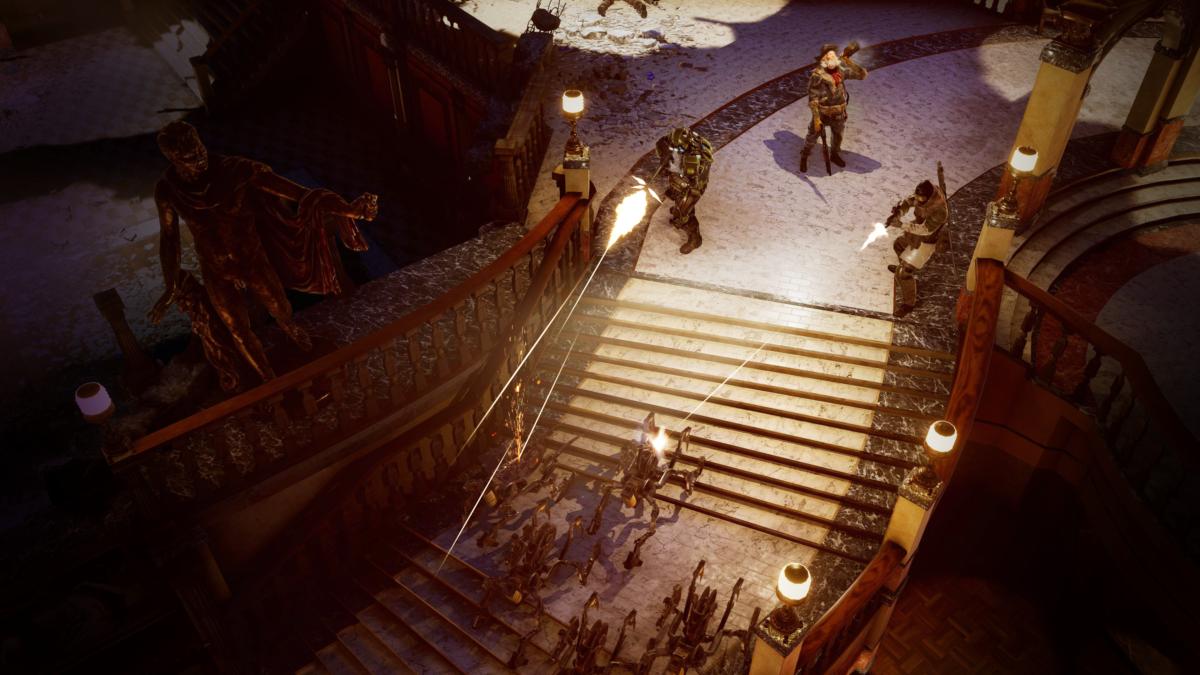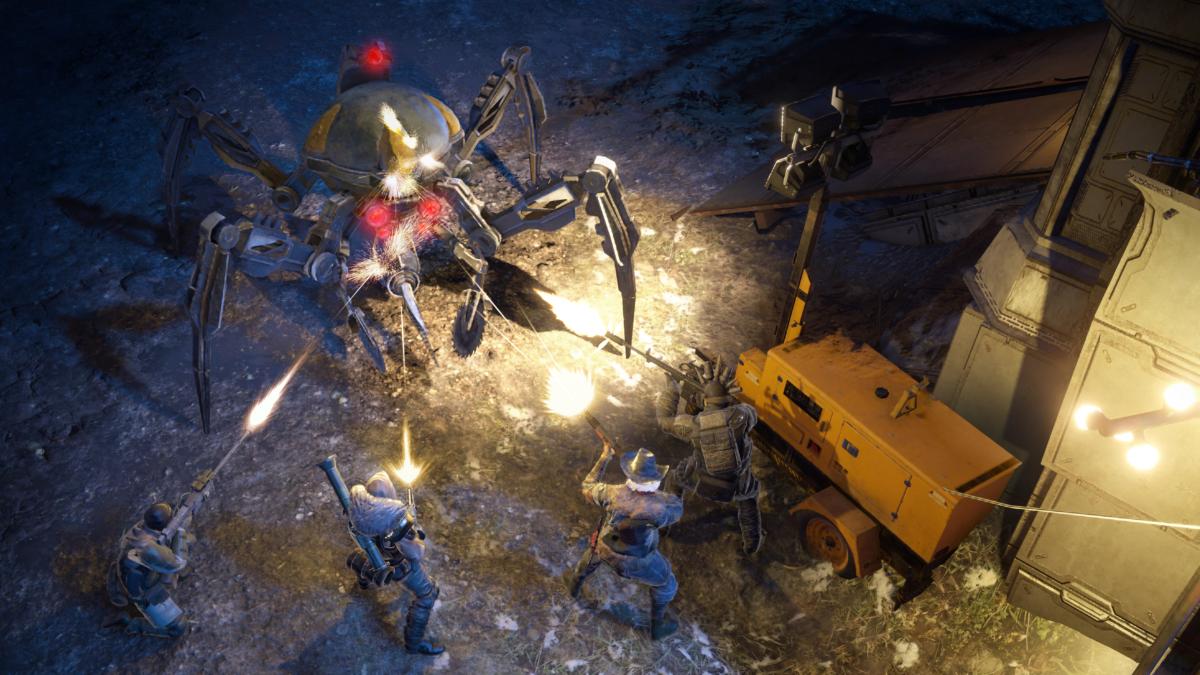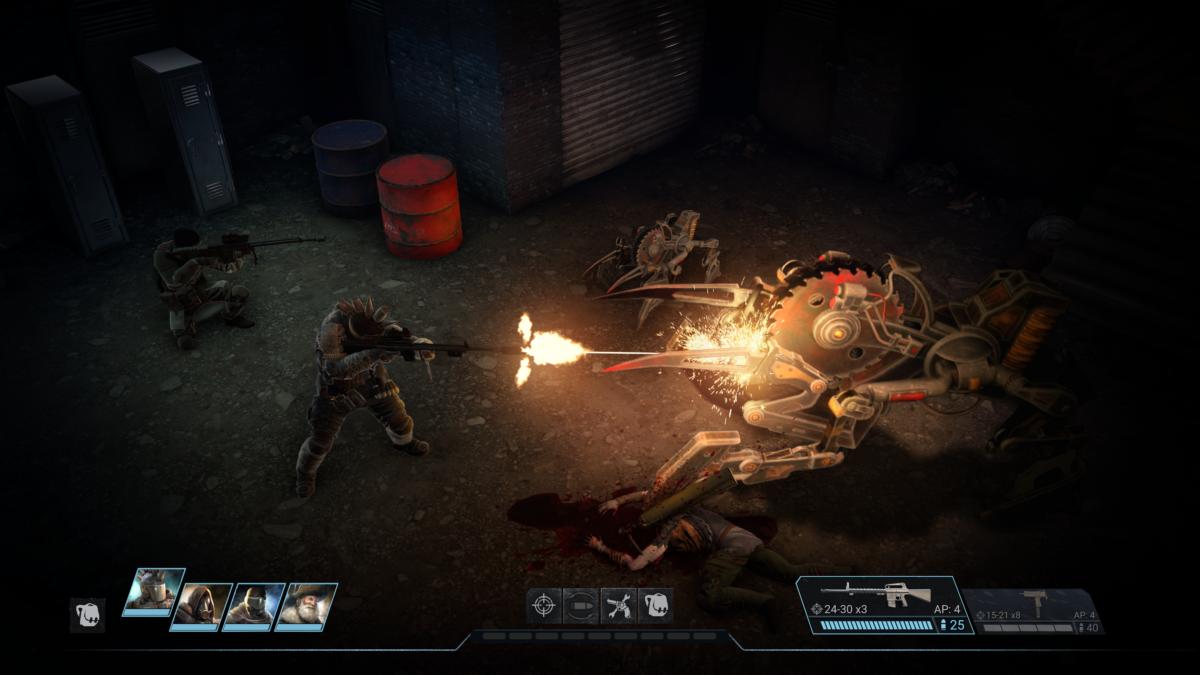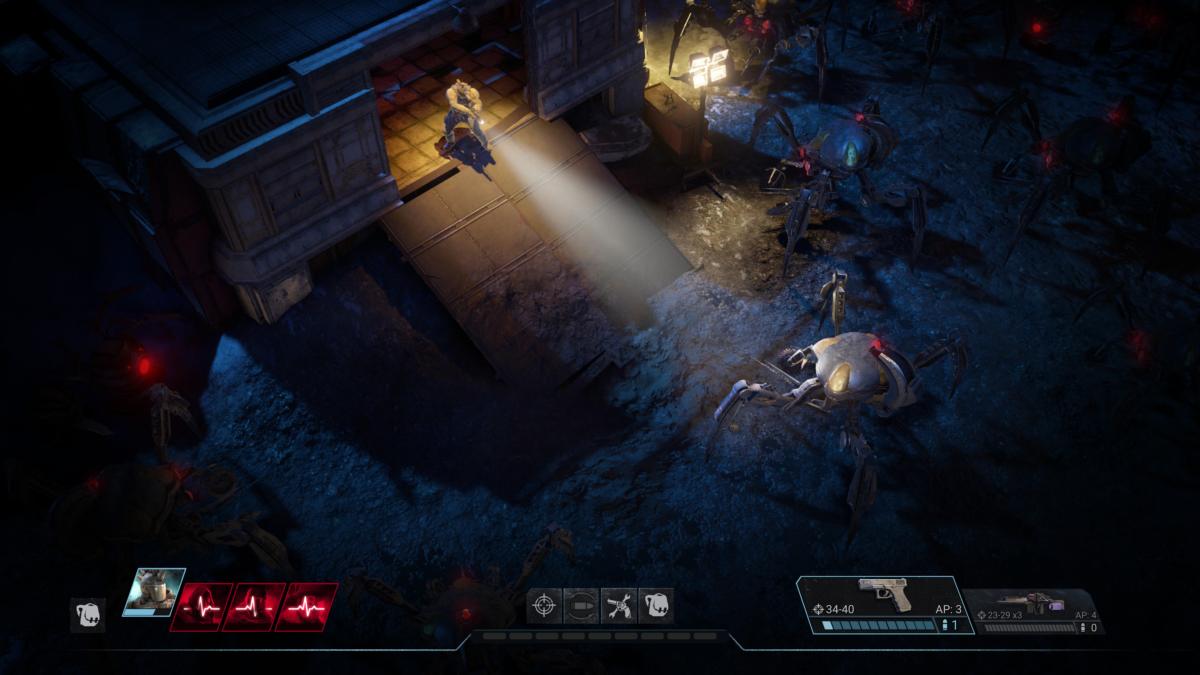-
Welcome to rpgcodex.net, a site dedicated to discussing computer based role-playing games in a free and open fashion. We're less strict than other forums, but please refer to the rules.
"This message is awaiting moderator approval": All new users must pass through our moderation queue before they will be able to post normally. Until your account has "passed" your posts will only be visible to yourself (and moderators) until they are approved. Give us a week to get around to approving / deleting / ignoring your mundane opinion on crap before hassling us about it. Once you have passed the moderation period (think of it as a test), you will be able to post normally, just like all the other retards.
You are using an out of date browser. It may not display this or other websites correctly.
You should upgrade or use an alternative browser.
You should upgrade or use an alternative browser.
Wasteland Wasteland 3 Pre-Release Thread [GO TO NEW THREAD]
- Thread starter Zorba the Hutt
- Start date
fantadomat
Arcane



I was expecting to come this few months,not a half a year later.
Darkzone
Arcane
- Joined
- Sep 4, 2013
- Messages
- 2,323
The question is not if it looks good, but if it is a decent RPG. And since a inXiles track record is not the best, we have to remain cautious.OK the game looks really good. Like really really good. And I'm not talking only about the graphics.
Hype initiated
BlackGoat
Arbiter
- Joined
- Sep 15, 2014
- Messages
- 505
Crap preview from Polygon. "Turn-based strategy game": https://www.polygon.com/2019/8/21/20825708/wasteland-3-pc-ps4-xbox-one-preview-gameplay-combat
Wasteland 3 is a prettier, more polished post-apocalypse
Turn-based strategy game simplifies combat and increases narrative elements
/cdn.vox-cdn.com/uploads/chorus_image/image/65079259/sc6v2s.0.jpg)
Wasteland 3 looks like a snowier, sleeker, and more substantial version of its five-year-old predecessor, Wasteland 2. I played a slice of the game earlier this week — based on a demo sent out to backers who helped crowdfund the game — and enjoyed the various tweaks and additions that have been added to the series’ team-based role-playing formula. This game’s budget, according to developer InXile, is three times larger than the last game.
The post-apocalyptic story moves on from Wasteland 2’s arid locations of Arizona and Los Angeles to the freezing heights of Colorado. Its story centers around a local boss called The Patriarch, who leads a society founded by formerly mega-wealthy Armageddon preppers.
Presented in overhead view, I play as a group of rangers who plough through flurried roads, from one dangerous location to another, seeking out The Patriarch’s outlandish adult-children. They’ve gone rogue, threatening to fracture the boss’s power.
My team of seven fighters now includes a vehicle that gets me to blizzard-bound outposts. I enjoy how the vehicle cuts through snowy roads, kicking up slush and dirt. In the overmap, I explore mountain roads until I come across a story beat, often in the form of a fight.
The game is built around a series of encounters between my raggedy rangers and gangs of enemies, including the usual post-nuclear roughnecks as well as robot dogs and other nasties.
Combat plays out XCOM-style. Each member of my party is a specialist such as a sniper or a close-quarters shotgun shooter. They carry two weapons as well as an extra piece of kit, like a grenade or a stand-alone gun turret. As the game progresses, they earn upgrades in their combat abilities and collect new weapons and armor. They also improve various skills such as mechanics and lock-picking and they bolt on social skills that help during narrative conversation tree sections.
The overarching aim is to nurture team members so that their skills become sufficiently advanced to progress, while also complementing one another. Non-combat solutions are often the best way forward, but these can only be accessed by characters who have unlocked specific skills.
Combat has been overhauled since the last game and feels more user-friendly. Instead of team members forming an orderly line to take their turns, I can pick and choose between my people, using action points to create the most effective tactical plays. Action points, as before, include ambushing enemies and shooting specific body parts as well as reloading or making use of consumables like health packs. Inventory (in single-player mode) is now shared among all characters, simplifying life enormously.
Usually, there are various access points and potential cover spots to use. Cover, sight-line, and elevation are all extremely important to successful combat, which works on the basis of statistical likelihood. If I try to shoot an enemy with a tiny percentage chance of hitting them, I’m likely to regret my folly.
My vehicle is a character in its own right, which adds mightily to combat situations, where it takes its turn in the fighting by shooting and squishing enemies, as well as removing obstacles and creating diversions. But it’s barred from some combat sections.
In the overmap, actions have also been simplified. If I need a player to, say, pick a lock, I click on the problem and the team member most able to deal with the task shows up. This helpful piece of user interaction was much demanded by players after the launch of Wasteland 2, and was added in the later Director’s Cut release.
Much of the extra budget has been spent on voice-acting and conversational scenes, in which various characters offer optional story paths. In my demo, I tracked down The Patriarch’s mad son, Victory, to the ruins of Aspen. Once cornered, we had a bit of a chat. I had an opportunity to either kill him, capture him, or allow him to join my team. Each of those options creates a different outcome when I next encounter The Patriarch. The story looks engrossing, as is often the case with InXile games.
Wasteland 3 is being published by Deep Silver and is coming out in spring 2010 for PC, PlayStation 4, and Xbox One.
This dude could not sound less enthused about writing that shit.
- Joined
- Apr 24, 2015
- Messages
- 21,272




Has anyone watching streams noticed change in how skills and stats work?
BEvers
I'm forever blowing
- Joined
- Aug 14, 2018
- Messages
- 808
Has anyone watching streams noticed change in how skills and stats work?
The alpha only allows you to see the inventory and attribute screens:

- Joined
- Jan 28, 2011
- Messages
- 100,708















They've said the squad size is six several times. Maybe the portraits can shrink to fit in more.
Last edited:
fantadomat
Arcane




This shit looks like mix between fallout and dos. The setting is what a twelve year old would think a fallout is and the combat looks like fucking dos,half the screen is in clouds of fire,poison,electricity etc etc. Also those blue health bars look terrible.
EDIT:Also why in all those videos the game is played by retards???
Last edited:

- Joined
- Apr 16, 2012
- Messages
- 9,460


because x-com didn't used themWhy don't they use hexagonseveryone knows hexagons are superior to squares
, squares are the popamole version of hexagons

duh...
because the UI is some insipid non-skeuomorphic shitfest that looks like it's for mobile, it means it's scalable and dynamic. 25 party members can be crammed in there!The current UI seems designed for "four party members + car":
- Joined
- Apr 24, 2015
- Messages
- 21,272




Those detection circles that enemies have reminds me of Mutant Year Zero.
- Joined
- Jan 28, 2011
- Messages
- 100,708















https://www.pcworld.com/article/343...atisfying-glimpse-of-the-post-apocalypse.html
Hands-on with Wasteland 3: A simplified but still satisfying glimpse of the post-apocalypse
If you backed Wasteland 3, you have a demo waiting for you. If you didn't, you'll have to live vicariously through us.
If you backed Wasteland 3’s crowdfunding attempt, today’s the day it bears fruit. InXile has created a short, combat-heavy demo-slash-alpha for people to dig into and give feedback on. If you didn’t back? Then you’ll have to live vicariously.
We met up with InXile earlier this week to play the very same slice of Wasteland 3. It’s been a long time coming, and I was excited—after all, this is the sequel to our 2014 Game of the Year.
A life well wasted
Though to be fair, Wasteland 2 didn’t win those accolades based on its combat. It was enjoyable, sure, resurrecting the turn-based tactics of the isometric Fallout entries. But Wasteland 2’s writing did the heavier part of the lifting, carrying a somewhat-rickety collection of mechanics to the top of our podium.
Writing is in short supply in the Wasteland 3 demo. No surprise there—InXile took a similar tack with the Bard’s Tale IV backer demo, a linear combat-driven dungeon crawl that was (in retrospect) barely reminiscent of the full game. It’s a shame though, as what I really want from a Wasteland 3 demo is a look at this new corner of the world, post-apocalyptic Colorado.
We do get a glimmer. It’s cold, a fact that should be abundantly clear if you’ve seen any of Wasteland 3’s trailers. Your ragtag Rangers trudge through and battle over thick snowdrifts—whether because of natural or nuclear winter, I don’t know.
The demo takes place in Aspen, where the Rangers have gone to track down Vic Buchanan and his “Breathers,” a gang that circulates hallucinogenics through their eponymous gas masks. The gang can be wiped out, but Vic is the son of the Patriarch of Colorado and needs to be taken alive, as part of a deal the Rangers have made with the Patriarch to secure his help.
That’s the setup, and about the sum total of the demo’s writing as well. There is a neat bit towards the end, a glimpse of Wasteland 3’s “cinematic conversations,” wherein the camera cuts to a fully voiced and animated close-up of Vic. It’s a dash of modernity in an otherwise retro-styled RPG, and leads to a great sight-gag where Vic slaps a corpse on the back and its head falls off.
But it’s over far too soon, and aside from Scotchmo’s combat barks there’s not much more writing to judge. Given InXile’s track record I’m not too worried, but it’s hard to make any concrete statements.
As for the rest of the demo? Two combat sections and a handful of puzzles await.
Wasteland 2 veterans will notice some changes immediately. The biggest, and one that sends shock waves through myriad other systems, is a rework of Initiative. In Wasteland 2, Initiative not only governed how early a character would attack, but how often as well. This enabled some extremely broken builds, where one character might attack as many as three times for each turn an enemy received. Meanwhile, slower characters like Scotchmo might fire their weapon one time per fight.
In Wasteland 3, turns function more like a standard tactics game where one side attacks, then the other attacks, and repeat. Gut instinct? It’s a good and necessary change. It’s easier to flank enemies and to coordinate maneuvers between teammates, and probably easier for InXile to balance as well. You can even have one party member attack, then hop over to another, and then go back to the first to attack again. This opens up some neat possibilities.
On the other hand, Wasteland 2’s flexibility—that ability to completely break the game by exploiting the systems given—was in line with its retro leanings and (for me at least) part of the fun. I’m somewhat sad to see it go, at least in this one respect.
Some aspects, I won’t miss as much. Characters now share an inventory, which is a welcome change. No more need to allocate ammo or health packs to each character individually, as they’ll all draw from the same pool. And skill checks are now semi-automatic. There’s no need to right-click a door, then tell someone to unlock it. If it’s locked, the Ranger with the highest lockpicking skill will automatically move to the door and try to get it open.
Something is lost in the simplification, no doubt. I don’t know if it’s something necessary though. Wasteland 3 feels less like a time capsule from 20 years ago, and in a way that’s a shame. It’s more playable though, and if we agree that its strongest suit is the writing? Then there’s no real need to lament the loss of the more fiddly mechanics.
Plus, it still takes the opportunity to trip you up when it can. There was a great moment midway through the demo where the path led through a cage full of bears. I carefully moved my squad away from the gate, except Scotchmo and his trusty shotgun. The plan? Spring the gate, and then have Scotchmo hit them right between the eyes. I opened the gate and…
I’d forgotten to reload Scotchmo’s shotgun after the last encounter. Oops.
Scotchmo was pretty good-natured as he fumbled a few shells into the shotgun, and we came out of it relatively unscathed. Still, it’s great to see certain elements of Wasteland 2 have carried over intact. This is still a crunchy CRPG at heart, even if some of the rough edges have been smoothed over.
It’s also beautiful. I’ve saved that to last, as in some ways it’s the least important aspect. Wasteland 2 looked ugly on release, and only marginally less so with the release of the overhauled Director’s Cut a year later. It didn’t matter.
But Wasteland 3 is downright stunning at times. The overworld map has clearly received the biggest upgrade, even if you only see a few seconds of it in the demo. InXile’s ditched Wasteland 2’s semi-abstracted map marker, replacing it with segments where you drive an armored truck around Colorado. The truck then joins you on encounter maps and in settlements, even taking part in combat provided it’s close enough to the action.
Character models are better too, probably in part because of the aforementioned “cinematic conversations.” Your own characters get the same treatment, and I’m told that Microsoft’s purchase of InXile has given them more opportunity to flesh out character customization (though that’s not part of the demo). Equipped armor is now visible as well, which is a nice touch.
Bottom line
At the end of the day it’s a short demo, and not one that focuses on the parts of Wasteland 3 I care most about. It’s rough too, I’ll say that as well. There are interface elements that need to be cleared up, and certain systems are still in flux. For instance, there’s currently no way to carry over action points from one round to another, meaning you might as well use them all up every single turn. I’m told that’ll probably change before release next spring.
The demo does get the point across though, at least I think. Wasteland 2 was deliberately retro, Wasteland 3 slightly less so. The foundation is still there, but it’s been updated a bit, for better and for worse. It’s a smoother experience, which usually means a more even-keeled experience but also a less flexible one—though it’ll take more than a half-hour demo to know for sure.
In any case, it doesn’t really matter. I’m here for the lore, the weird bits, the Breathers and Vic, the Patriarch and the Rangers. As long as I can plug through combat at a decent clip to get to more dialogue, I’ll be happy.
- Joined
- Jan 28, 2011
- Messages
- 100,708















https://www.gamereactor.eu/wasteland-3-will-be-a-nice-jumpingon-point-for-new-players/
Wasteland 3 will be a "nice 'jumping-on' point" for new players
We sat down with InXile Entertainment's Tim Campbell at Gamescom to talk about the upcoming action RPG Wasteland 3.
While the release of Wasteland 3 was pushed into 2020 after the Microsoft acquisition earlier this year, RPG fans are as excited as ever for the third instalment in the popular franchise. We spoke to InXile Entertainment's Tim Campbell at Gamescom just recently and regardless of your knowledge of the series, you'll have a good time playing. Campbell explained:
"I think it actually strikes a good balance between both of those [the previous Wasteland games]. Wasteland 3 takes place after Wasteland 2 chronologically, so the rangers have gone ahead and wrapped up Wasteland 2. I don't want to give any spoilers for people who haven't played it, but the rangers are basically in a hard spot after the game before this. They're kind of desperate, they're needing help. they're needing supplies and they're really struggling to find their footing in the new era and that's when the Patriarch's call comes in, you get this radio call from the ruler of Colorado and he effectively strikes a bargain with you: that he will provide the supplies to help the rangers continue on but he needs you to come and help solve a succession crisis".
"Chronologically, we tell the next chapter of the story but because it takes place in a very different setting, Wasteland 2 was in the desert, in Wasteland 3 you move from Arizona and you've now travelled a long distance to Colorado, to this frigid, nuclear winter hellscape that they have, it effectively is a nice 'jumping-on' point for new players who haven't played. I think players who are returning will find a lot to like because it continues, there are some characters that actually span both games that they'll recognise".
So Wasteland 3 will bring e nice challenge and a great experience for veterans and new players alike. Speaking of great experiences, the series has always had its players choose where they want to stand with the factions they're interacting with and that's no different in Wasteland 3.
"We build our world and we build our quests and our NPCs in a way that you can do anything you want in any order, you can kill critical story NPCs and the world will react to that and keep going," Campbell said before continuing, "You're able to befriend the bad guys, you're able to attack the good guys, you're able to mix and how you want to play it will be different from how other people are going to play it, so you'll see the world react and unfold in a different way".
"The world map is one one of the ways that we show this because it's this frigid landscape that you can drive around on and a lot of games really holds your hand or kind of guides you and that's not really what we're about at inXile. With these games, we really like to leave it up to the players to define their own story so we have this landscape, you have a vehicle that you can upgrade and we let you loose into the world, and you can explore it however you want to explore it".
You can check the interview in its entirety below if you so wish, but to play the game, we all have to wait for its release on PC, PlayStation 4 and Xbox One in spring of 2020.
Comte
Guest
Sounds like they ripped off the nuxcom system
- Joined
- Jan 28, 2011
- Messages
- 100,708















Well it's also the old X-COM system.  "Squad turn-based".
"Squad turn-based".
 "Squad turn-based".
"Squad turn-based".Comte
Guest
Well it's also the old X-COM system."Squad turn-based".
Oh you meant the Squad leader system that old xcom ripped off
- Joined
- Jan 28, 2011
- Messages
- 100,708















- Joined
- Jan 28, 2011
- Messages
- 100,708















The Patriarch's psycho son is called Vic Buchanan. We've seen that last name before: https://rpgcodex.net/article.php?id=10458
[From the letters of Doctor Ellen Buchanan, dated 2022 - twenty-five years after the bombs fell. Housed in the Patriarch’s personal archive, Colorado Springs.]
So she was an ancestor.
Last edited:
- Joined
- Jan 28, 2011
- Messages
- 100,708















Found another preview: https://www.pastemagazine.com/articles/2019/08/wasteland-3-preview.html
It's funny to me how all these storyfag previewers are concerned about the game being streamlined but Codexers mostly don't seem to give a fuck.
Wasteland 3 Improves on Everything Except the Story
Following the crowdfunding success of 2014’s Wasteland 2, there’s a lot for Wasteland 3 to live up to. Paste traveled down to San Francisco to take a look at the upcoming title, from the newly Microsoft-acquired InXile Entertainment, and even in its relatively early alpha state, it looks to be miles ahead of its predecessor in strategic options, combat, and graphical fidelity. Time will tell if it manages to tell a great story.
Unlike the American southwest desert locales of Wasteland 2, Wasteland 3 shifts the game’s setting to the hills of Colorado. Immediately, the sequel jumps out with a much more streamlined UI, something that may rub more experienced CRPG fans a little oddly. While Wasteland 2 felt like a throwback, with a sizeable portion of the screen devoted to just text, Wasteland 3’s UI feels like a modern turn-based strategy game, like the rebooted XCOM.
Part of this, as lead level designer Jeremy Kopman tells me, is due to the support and funding that Wasteland 3 has. The game is fully voice acted, and conversation trees are reminiscent of a modern Bethesda title, instead of more classic CRPG-style dialogue as seen in the predecessor. The top-down traversal and freeform exploration return, and all characters can be equipped with various armors, weapons, and weapon mods that are reflected in their appearance.
The demo focused on a section of the game in Aspen, Colorado, which has been overtaken by the son of the Colorado patriarch, who’s been strong-armed into helping your gang of Rangers. The previous game’s simple world map of 2D icons and place markers has been replaced with a moody, fully-3D and atmospheric overhead view of the region, and in the center of your screen is Wasteland 3’s biggest and most impactful new addition: A Big Truck.
I didn’t get the Truck’s name, it’s not really important. What is important is that in Wasteland 3, your crew gets around in a huge, kitted-out truck with tank treads and a big-ass gun on top. It’s customizable, Kopman told me, in both cosmetic and mechanical ways. While none of this was available in the demo, Kopman explained that there would be multiple chassis options, weapons, paint colors, and various other upgrades and options to customize your rig.
The Big Truck isn’t just a cool map traversal vehicle, either. Once I made my way through the snowy hills to the gates of Aspen and the game transitioned from the world map to a level map, I quickly found myself in combat with a gang of bandits guarding the front entrance. To my surprise and childish delight, it turns out that your truck can act in combat, both to rush forward and run over enemies (and cover objects like barrels and sandbags) but to handily obliterate enemies with its mounted weapon.
The addition of the Big Truck fundamentally changes a lot of Wasteland’s combat. It’s easy to see how it would be overpowered in many situations, but it’s also clear that the size of the truck means that it isn’t going to be available in all battles. Once I cleared out the bandits at Aspen’s front gates, I had to pass through to an inner area by bridge—a bridge too small to bring along the Big Truck. Goodbye for now, sweet friend.
Indeed, a lot of Wasteland 3’s combat has been re-envisioned and mechanically tightened. Precision Strikes (making a return from the Director’s Cut edition of Wasteland 2), with their 100% hit rate and added status effects, make excellent final shot tools. Destructible cover, coupled with a slightly tweaked combat system that allows you to move all your units in one turn (rather than staggering their turns throughout all combatants in a battle) means that you can set up and execute combinations more easily and fluidly—an explosive to take out the enemy cover, followed up by another squad member delivering a quick kill.
As a combat-focused demo, there wasn’t as much in the way of character interactions or much plot reveals, but the playthrough culminated with confronting the patriarch’s son, Vic, in an abandoned warehouse. While all conversations in the game will be fully voiced, certain interactions (like this one with Vic) are also fully motion-captured with an actor, meaning that alongside the (very well-done) voice acting, some characters will also have entirely bespoke animations in conversations. It’s a little thing, but another example of the game exhibiting a stunning amount of polish, even in this early state.
Where I was impressed and intrigued by the game’s mechanical changes, I was left a little cold on the story and setting as it was presented. Wasteland 3 looks to have a firm grasp on its world, but at least so far, it doesn’t seem to offer much beyond some classic post-apocalyptic character and setting tropes. Vic, the patriarch’s wayward son, is a nihilistic, trigger-happy type; companion Scotchmo is a hobo who likes… scotch; and the Patriarch himself (from what little we’ve seen) is a warlord bent on preserving his domain.
Aspen, controlled by a gang of bandits upon your arrival, is covered in giant graffiti mocking the town’s former (wealthy) residents, including some bloody graffiti of “Eat The Rich.” Which is funny, I suppose, because, the bandits maybe actually ate them? It’s the type of thing that felt somewhat empty and lacking in a real message or thrust, just using the symbols of ideology to prop up what (so far) seem to be bog-standard character tropes.
That’s not to say that these early disappointments can’t be improved, or that the team hasn’t proven their ability to do so. Tropes are only bad when they’re lazy, not when they’re handled with a deft hand and given room to grow. With the rest of the demo being so strong, the characters and scenarios seen so far couldn’t help but feel lackluster in comparison. Hopefully when we finally get a chance to explore Colorado sometime in 2020, it’ll be a place worth taking a post-apocalyptic vacation in.
It's funny to me how all these storyfag previewers are concerned about the game being streamlined but Codexers mostly don't seem to give a fuck.
- Joined
- Apr 24, 2015
- Messages
- 21,272




Retardation of systems was accepted as inevitable since the first gameplay video.It's funny how all these storyfag previewers are concerned about the game being streamlined but Codexers mostly don't seem to give a fuck.
rusty_shackleford
Arcane
- Joined
- Jan 14, 2018
- Messages
- 50,754

You'd have to be retarded to think WL2 was a storyfag game to begin with.

















